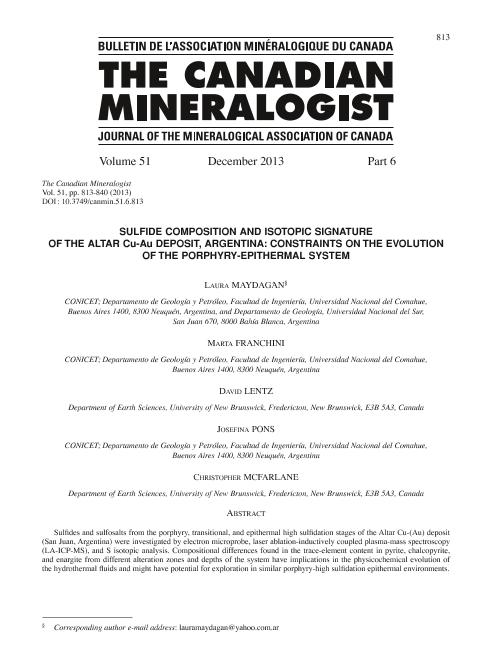Artículo
Sulfide Composition and Isotopic Signature of the Altar Cu-Au Deposit, Argentina: constraints on the Evolution of the Porphyry-Epithermal System
Maydagán, Laura ; Franchini, Marta Beatriz
; Franchini, Marta Beatriz ; Lentz, Dave ; Pons, María Josefina
; Lentz, Dave ; Pons, María Josefina ; McFarlane, Christopher
; McFarlane, Christopher
 ; Franchini, Marta Beatriz
; Franchini, Marta Beatriz ; Lentz, Dave ; Pons, María Josefina
; Lentz, Dave ; Pons, María Josefina ; McFarlane, Christopher
; McFarlane, Christopher
Fecha de publicación:
12/2013
Editorial:
Mineralogical Assoc Canada
Revista:
Canadian Mineralogist
ISSN:
0008-4476
Idioma:
Inglés
Tipo de recurso:
Artículo publicado
Clasificación temática:
Resumen
Sulfides and sulfosalts from the porphyry, transitional, and epithermal high sulfidation stages of the Altar Cu-(Au) deposit (San Juan, Argentina) were investigated by electron microprobe, laser ablation-inductively coupled plasma-mass spectroscopy (LA-ICP-MS), and S isotopic analysis. Compositional differences found in the trace-element content in pyrite, chalcopyrite, and enargite from different alteration zones and depths of the system have implications in the physicochemical evolution of the hydrothermal fluids and might have potential for exploration in similar porphyry-high sulfidation epithermal environments. Low contents of most analyzed trace elements were found in chalcopyrite ± pyrite from the potassic alteration, except for Zn, Sn, and Ag in chalcopyrite, and Co and Ni in pyrite. During the phyllic alteration, cooling of the fluids and a decrease of its pH (<4.5) produced the leaching and re-precipitation of the sulfides from the previous stage. The reprecipitated chalcopyrite and pyrite show micro-inclusions of Au (Ag alloys) and sulfosalts with As, Ag, V, Zn, Sn, Bi, and Sb that are interpreted to correlate with changes in the composition of the fluids. In the transitional veins and their selvages, early precipitation of bornite + pyrite and the weak kaolinite + quartz alteration envelope indicate a decrease in the temperature (<200 °C) and pH (<4) of the fluids and an increase of the fS2. This stage was followed by a sudden increase in the fO2 of the fluid and a slight decrease in the fS2, and bornite was replaced by tennantite (vein type E1). A trend toward higher fS2 favored enargite precipitation (vein type E3). Traces of Au found in tennantite and enargite therefore indicate that fluctuations in the oxidation state of the fluids promoted gold precipitation in the Altar porphyry system. Negative S isotope values (δ34S: –1.7 to –3.0‰) obtained for the sulfides and sulfosalts from the potassic, phyllic, and transitional stages at Altar are consistent with oxidizing (SO4 2– dominant) mineralizing fluids. The precipitation of sphalerite (δ34S = –4.4‰ and low concentration of FeS) and galena associated with calcite + anhydrite in late fractures (vein type 8) reflect cooling of the fluids and a slight increase of its pH at higher fO2, as the system moved to greater depths. The typical advanced argillic assemblages are not developed at the Altar porphyry deposit, indicating that fluids did not attain very low pH conditions. In contrast, enargite from the epithermal siliceous ledges located above the porphyry deposit precipitated with low pH mineral assemblages (quartz + alunite) and has a distinctive lighter δ34S value of –5.4‰, consistent with a decrease of temperature, pH, and/or an increase in the oxidation state of the fluids during its deposition. Enargite from the transitional stage veins of the porphyry deposit is enriched in Zn, Sb, Ag, and Bi, whereas enargite from the epithermal environment has much lower concentrations of trace elements, except for isolated inclusions of Au-Bi.
Palabras clave:
Trace Elements
,
Sulfides
,
S Isotopes
,
Porphyry-Epithermal
Archivos asociados
Licencia
Identificadores
Colecciones
Articulos(CCT - PATAGONIA NORTE)
Articulos de CTRO.CIENTIFICO TECNOL.CONICET - PATAGONIA NORTE
Articulos de CTRO.CIENTIFICO TECNOL.CONICET - PATAGONIA NORTE
Citación
Maydagán, Laura; Franchini, Marta Beatriz; Lentz, Dave ; Pons, María Josefina; McFarlane, Christopher ; Sulfide Composition and Isotopic Signature of the Altar Cu-Au Deposit, Argentina: constraints on the Evolution of the Porphyry-Epithermal System; Mineralogical Assoc Canada; Canadian Mineralogist; 51; 6; 12-2013; 813-840
Compartir
Altmétricas



